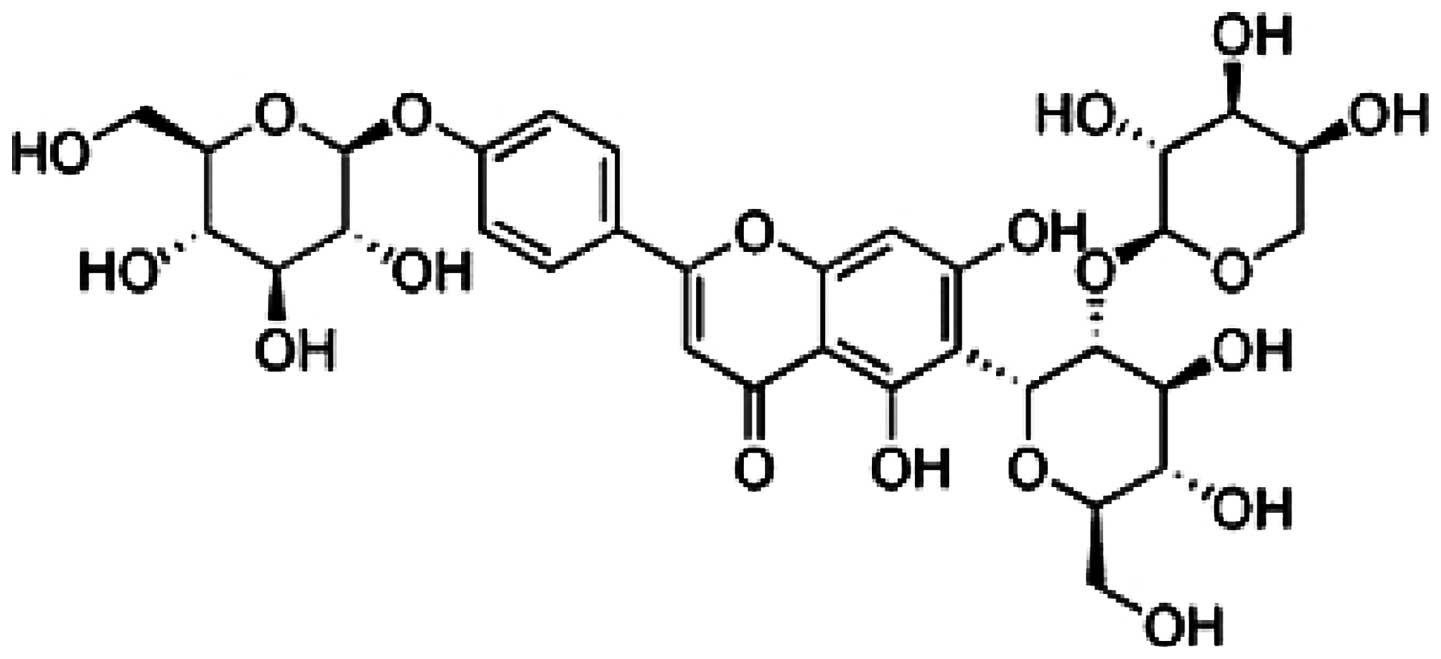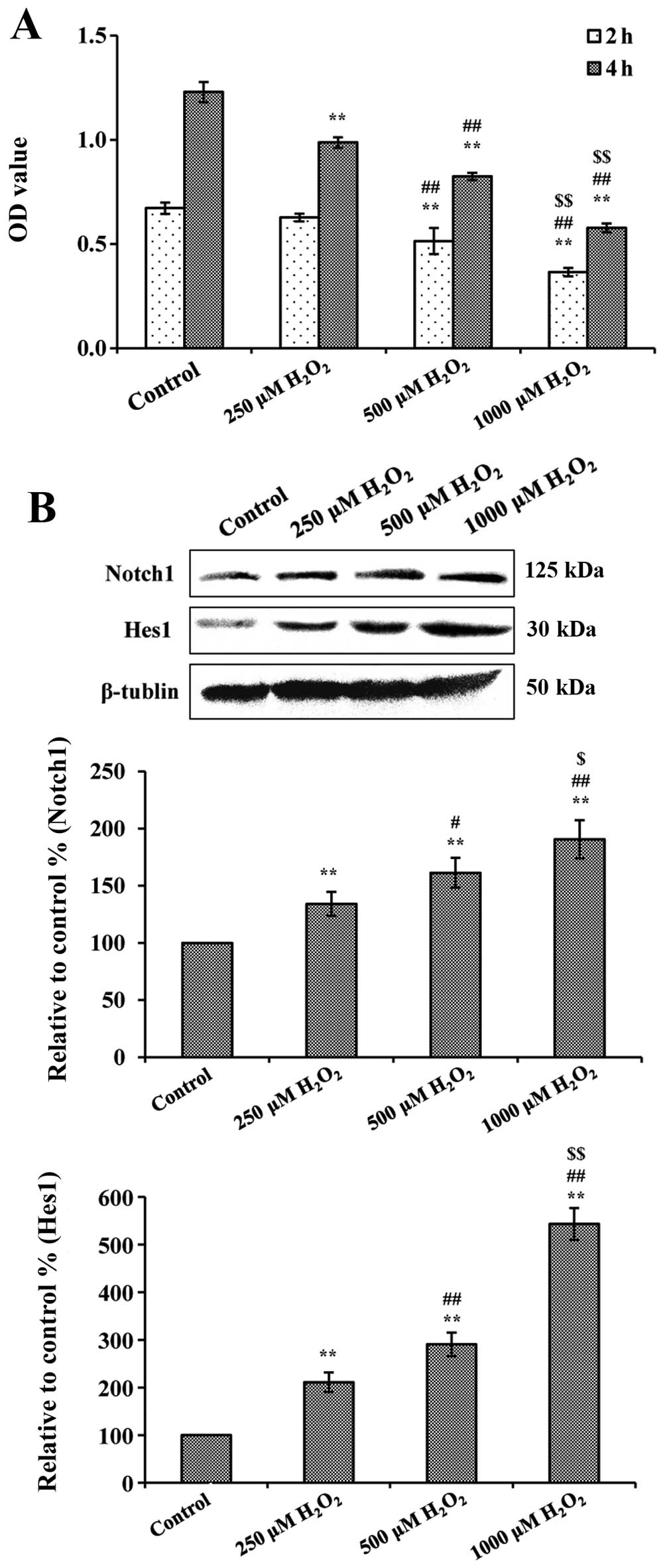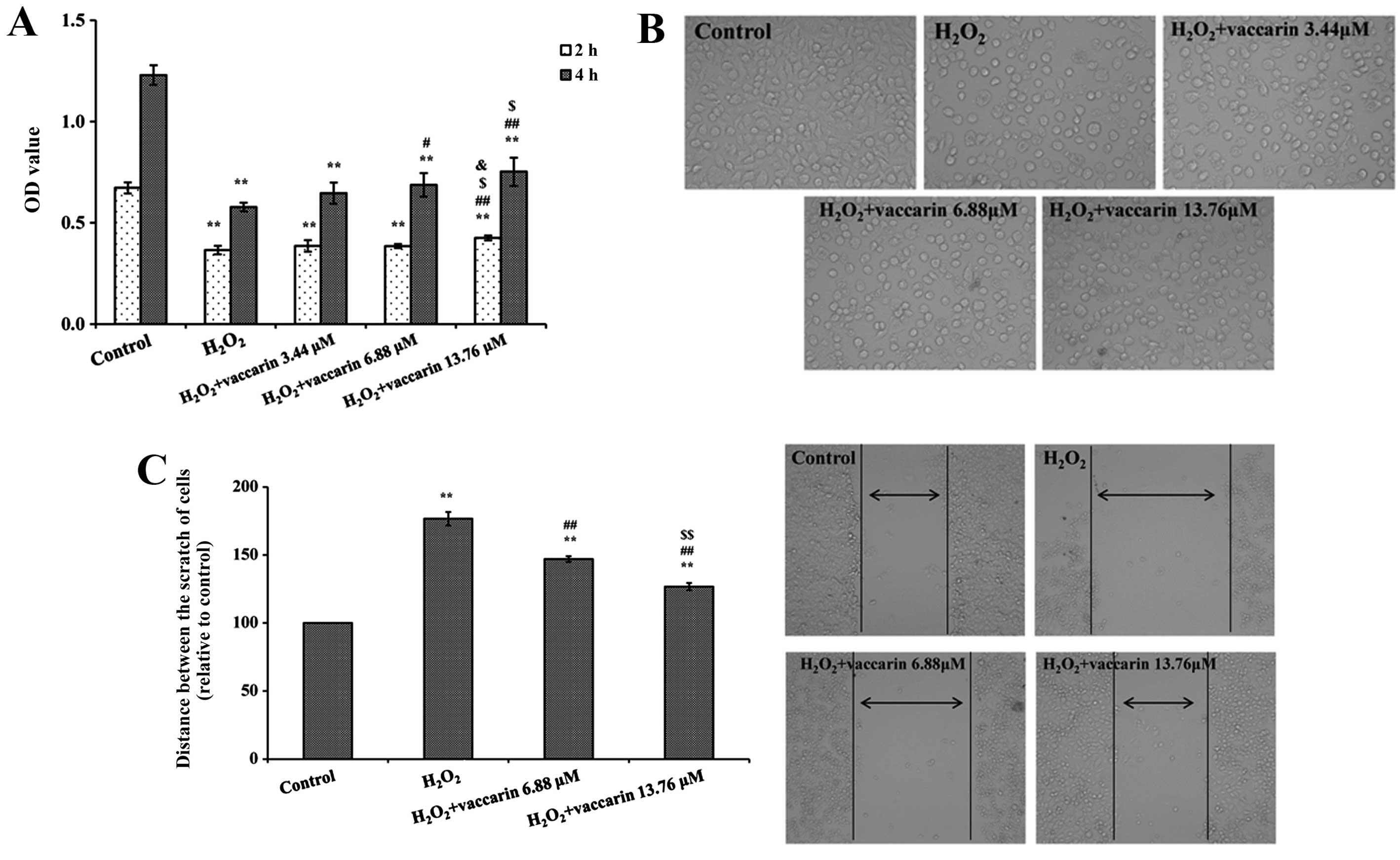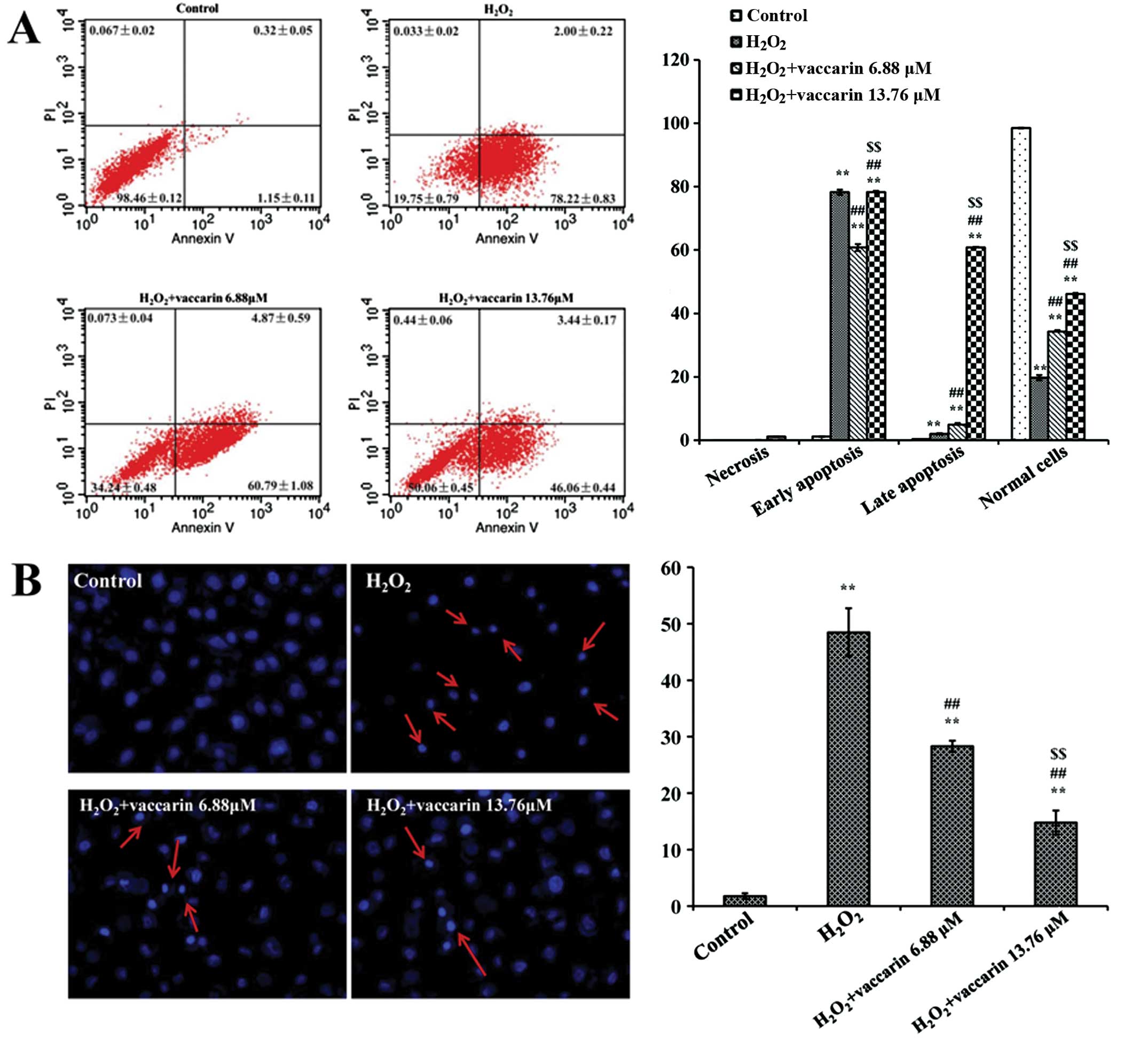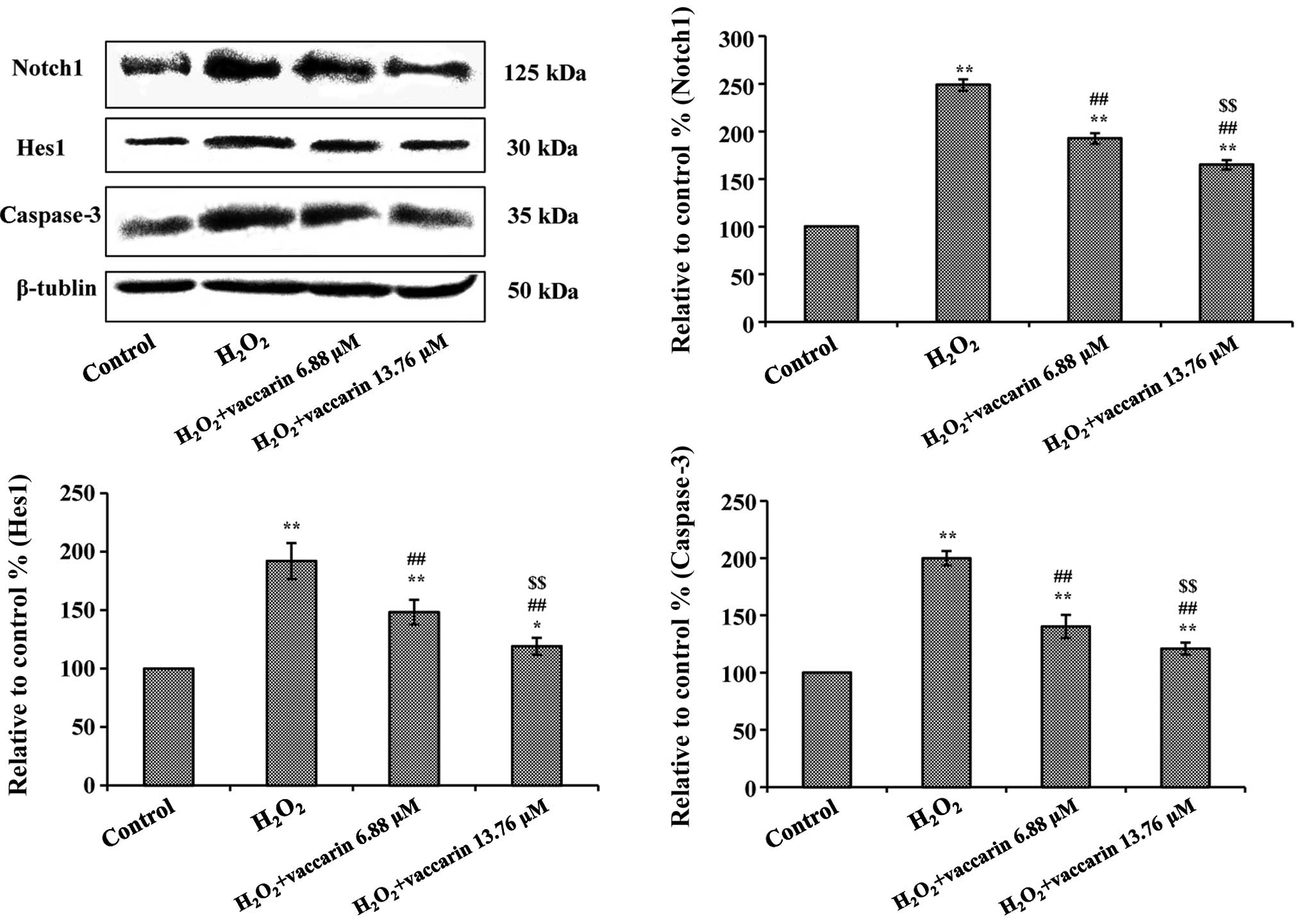|
1
|
Beckman JA, Creager MA and Libby P:
Diabetes and atherosclerosis: epidemiology, pathophysiology, and
management. JAMA. 287:2570–2581. 2002. View Article : Google Scholar : PubMed/NCBI
|
|
2
|
Malakul W, Thirawarapan S, Suvitayavat W
and Woodman OL: Type 1 diabetes and hypercholesterolaemia reveal
the contribution of endothelium-derived hyperpolarizing factor to
endothelium-dependent relaxation of the rat aorta. Clin Exp
Pharmacol Physiol. 35:192–200. 2008.
|
|
3
|
McNulty PH, Tulli MA, Robertson BJ, et al:
Effect of simulated postprandial hyperglycemia on coronary blood
flow in cardiac transplant recipients. Am J Physiol Heart Circ
Physiol. 293:H103–H108. 2007. View Article : Google Scholar : PubMed/NCBI
|
|
4
|
Vita JA: Endothelial function and clinical
outcome. Heart. 91:1278–1279. 2005. View Article : Google Scholar : PubMed/NCBI
|
|
5
|
Schulz E, Dopheide J, Schuhmacher S, et
al: Suppression of the JNK pathway by induction of a metabolic
stress response prevents vascular injury and dysfunction.
Circulation. 118:1347–1357. 2008. View Article : Google Scholar : PubMed/NCBI
|
|
6
|
Yada T, Shimokawa H, Hiramatsu O, et al:
Hydrogen peroxide, an endogenous endothelium-derived
hyperpolarizing factor, plays an important role in coronary
autoregulation in vivo. Circulation. 107:1040–1045. 2003.
View Article : Google Scholar : PubMed/NCBI
|
|
7
|
West XZ, Malinin NL, Merkulova AA, et al:
Oxidative stress induces angiogenesis by activating TLR2 with novel
endogenous ligands. Nature. 467:972–976. 2010. View Article : Google Scholar : PubMed/NCBI
|
|
8
|
Chen CA, Wang TY, Varadharaj S, et al:
S-glutathionylation uncouples eNOS and regulates its cellular and
vascular function. Nature. 468:1115–1118. 2010. View Article : Google Scholar : PubMed/NCBI
|
|
9
|
Wu XG and Li L: Rosiglitazone suppresses
lipopolysaccharide-induced matrix metalloproteinase-2 activity in
rat aortic endothelial cells via Ras-MEK1/2 signaling. Int J
Cardiol. 158:54–58. 2012. View Article : Google Scholar
|
|
10
|
Zanchetti A, Hennig M, Hollweck R, et al:
Baseline values but not treatment-induced changes in carotid
intima-media thickness predict incident cardiovascular events in
treated hypertensive patients: findings in the European Lacidipine
Study on Atherosclerosis (ELSA). Circulation. 120:1084–1090. 2009.
View Article : Google Scholar : PubMed/NCBI
|
|
11
|
Yang Y, Duan WX, Liang ZX, et al: Curcumin
attenuates endothelial cell oxidative stress injury through Notch
signaling inhibition. Cell Signal. 25:615–629. 2013. View Article : Google Scholar
|
|
12
|
Rosenbaum MA, Miyazaki K and Graham LM:
Hypercholesterolemia and oxidative stress inhibit endothelial cell
healing after arterial injury. J Vasc Surg. 55:489–496. 2012.
View Article : Google Scholar :
|
|
13
|
Cook KM and Figg WD: Angiogenesis
inhibitors: Current strategies and future prospects. CA Cancer J
Clin. 60:222–243. 2010. View Article : Google Scholar : PubMed/NCBI
|
|
14
|
Ji X, Wang Z, Geamanu A, Sarkar FH and
Gupta SV: Inhibition of cell growth and induction of apoptosis in
non-small cell lung cancer cells by delta-tocotrienol is associated
with notch-1 down-regulation. J Cell Biochem. 112:2773–2783. 2011.
View Article : Google Scholar : PubMed/NCBI
|
|
15
|
Samon JB, Champhekar A, Minter LM, et al:
Notch1 and TGFb1 cooperatively regulate Foxp3 expression and the
maintenance of peripheral regulatory T cells. Blood. 112:1813–1821.
2008. View Article : Google Scholar : PubMed/NCBI
|
|
16
|
Maciej J and Krzysztof S: Notch: A new
player in MS mechanisms. J Neuroimmunol. 218:3–11. 2010. View Article : Google Scholar
|
|
17
|
Androutsellis-Theotokis A, Leker RR,
Soldner F, et al: Notch signalling regulates stem cell numbers in
vitro and in vivo. Nature. 442:823–826. 2006. View Article : Google Scholar : PubMed/NCBI
|
|
18
|
McCright B: Notch signaling in kidney
development. Curr Opin Nephrol Hypertens. 12:5–10. 2003. View Article : Google Scholar
|
|
19
|
Archana VB, Karl DP, Pao LC, Yoon YS and
Michael ED: Oxidative stress-induced Notch1 signaling promotes
cardiogenic gene expression in mesenchymal stem cells. Stem Cell
Res Ther. 4:2–15. 2013.
|
|
20
|
Campos J, Schmeda-Hirschmann G, Leiva E,
et al: Lemon grass (Cymbopogon citratus (D.C) Stapf) polyphenols
protect human umbilical vein endothelial cell (HUVECs) from
oxidative damage induced by high glucose, hydrogen peroxide and
oxidised low-density lipoprotein. Food Chem. 151:175–181. 2014.
View Article : Google Scholar : PubMed/NCBI
|
|
21
|
Jin RG, Wang QJ and Yan TH: Protective
effects of salidroside on human umbilical vein endothelial cells.
Pharmacology and Clinics of Chinese Materia Medical. 28:41–44.
2012.
|
|
22
|
China Pharmacopoeia Committee. Chinese
Pharmacopoeia: The 2010 edition. China Medical Science Press;
Beijing, China: pp. 49–50. 2010
|
|
23
|
Sang SM, Lao A and Chen ZL: Chemistry and
bioactivity of the seeds of Vaccaria segetalis. Orient Foods Herbs.
21:279–291. 2000.
|
|
24
|
Li F and Liang JY: Research progress of
Vaccaria segetalis. Straits Pharm J. 3:1–5. 2007.
|
|
25
|
Koike K, Jia ZH and Nikaido T:
Triterpenoid saponins from Vaccaria segetalis. Phytochemistry.
7:13431998. View Article : Google Scholar
|
|
26
|
Sang SM, Lao AN and Wang HC: A
phenylpropanoid glycoside from Vaccaria segetalis. Phytochemistry.
48:569–571. 1998. View Article : Google Scholar
|
|
27
|
Sang S, Lao A and Wang H: Triterpenoid
saponin from Vaccaria segetalis. J Asian Nat Prod Res. 1:199–205.
1999. View Article : Google Scholar
|
|
28
|
Yun YS, Morita H, Takeya K, et al: Cyclic
peptides from higher plants. 34. segetalins G and H, structures and
estrogen-like activity of cyclic pentapeptides from Vaccaria
segetalis. J Nat Prod. 60:216–218. 1997. View Article : Google Scholar : PubMed/NCBI
|
|
29
|
Morita H, Young SY, Takeya K, et al: A
cyclic heptapeptide from Vaccaria segetalis. Phytochemistry.
42:439–441. 1996. View Article : Google Scholar : PubMed/NCBI
|
|
30
|
Dong Z and Chen N: Study on the TLC
identification method of Wangbuliuxing tablets. China For Med
Treat. 30:1282011.
|
|
31
|
Li N, Ma CH, Liu D, et al: Chemical
constituents analysis of fried Vaccaria segetafis. Chin J Exptl
Tradit Med Form. 19:73–75. 2013.
|
|
32
|
Sun YX, Liang HT, Zhang XT, et al:
Structural elucidation and immunological activity of a
polysaccharide from the fruiting body of Armillaria mellea. Biores
Technol. 100:1860–1863. 2009. View Article : Google Scholar
|
|
33
|
Sun Y, Wang S, Li T, et al: Purification
structure and immunobiological activity of a new water-soluble
polysaccharide from the mycelium of Polyporus albicans (Imaz) Teng.
Biores Technol. 99:900–904. 2008. View Article : Google Scholar
|
|
34
|
Meng H, Chen Y, Qin W, et al:
Determination of vaccarin in Vaccariae Semen by HPLC. Zhongguo
Zhong Yao Za Zhi. 35:2072–2074. 2010.PubMed/NCBI
|
|
35
|
Xia MX, Feng L and Zhang LF: Isolation,
Purification and Identification of Chemical Compound from Semen
vaccariae to Inhibit Endothelial Cells. Biotechnology Bulletin.
2:93–97. 2009.
|
|
36
|
Cheong SM, Choi H, Hong BS, Gho YS and Han
JK: Dab2 is pivotal for endothelial cell migration by mediating
VEGF expression in cancer cells. Exp Cell Res. 318:550–557. 2012.
View Article : Google Scholar : PubMed/NCBI
|
|
37
|
Liu HT, Li WM, Xu G, et al: Chitosan
oligosaccharides attenuate hydrogen peroxide-induced stress injury
in human umbilical vein endothelial cells. Pharmacol Res.
59:167–175. 2009. View Article : Google Scholar : PubMed/NCBI
|
|
38
|
Li B, Qiu T, Zhang P, Wang X, Yin Y and Li
S: IKVAV regulates ERK1/2 and Akt signalling pathways in BMMSC
population growth and proliferation. Cell Prolif. 47:133–145. 2014.
View Article : Google Scholar : PubMed/NCBI
|
|
39
|
Liang KW, Lee WJ, Lee WL, Chen YT, Ting CT
and Sheu WH: Diabetes exacerbates angiographic coronary lesion
progression in subjects with metabolic syndrome independent of CRP
levels. Clin Chim Acta. 388:41–45. 2008. View Article : Google Scholar
|
|
40
|
Dikalov SI, Dikalova AE, Bikineyeva AT,
Schmidt HH, Harrison DG and Griendling KK: Distinct roles of Nox1
and Nox4 in basal and angiotensin II-stimulated superoxide and
hydrogen peroxide production. Free Radical Biol Med. 45:1340–1351.
2008. View Article : Google Scholar
|
|
41
|
Li JK, Ge R, Tang L and Li QS: Protective
effects of farrerol against hydrogen-peroxide-induced apoptosis in
human endothelium-derived EA.hy926 cells. Can J Physiol Pharmacol.
91:733–740. 2013. View Article : Google Scholar : PubMed/NCBI
|
|
42
|
Noseda M, McLean G, Niessen K, et al:
Notch activation results in phenotypic and functional changes
consistent with endothelial-to-mesenchymal transformation. Circ
Res. 94:910–917. 2004. View Article : Google Scholar : PubMed/NCBI
|
|
43
|
Williams CK, Li JL, Murga M, Harris AL and
Tosato G: Up-regulation of the Notch ligand Delta-like 4 inhibits
VEGF-induced endothelial cell function. Blood. 107:931–939. 2006.
View Article : Google Scholar
|
|
44
|
MacKenzie F, Duriez P, Wong F, Noseda M
and Karsan A: Notch4 inhibits endothelial apoptosis via
RBP-Jkappa-dependent and -independent pathways. J Biol Chem.
279:11657–11663. 2004. View Article : Google Scholar : PubMed/NCBI
|
|
45
|
Ding X, Zhu F, Li T, Zhou Q, Hou FF and
Nie J: Numb Protects Renal Proximal Tubular Cells from Puromycin
Aminonucleoside-Induced Apoptosis through Inhibiting Notch
Signaling Pathway. Int J Biol Sci. 7:269–278. 2011. View Article : Google Scholar : PubMed/NCBI
|
|
46
|
Stampfer MJ, Hennekens CH, Manson JE,
Colditz GA, Rosner B and Willett WC: Vitamin E consumption and the
risk of coronary disease in women. N Engl J Med. 328:1444–1449.
1993. View Article : Google Scholar : PubMed/NCBI
|
|
47
|
Rimm EB, Stampfer MJ, Ascherio A,
Giovannucci E, Colditz GA and Willett WC: Vitamin E consumption and
the risk of coronary heart disease in men. N Engl J Med.
328:1450–1456. 1993. View Article : Google Scholar : PubMed/NCBI
|
|
48
|
Chen SD, Yin JH, Hwang CS, Tang CM and
Yang DI: Anti-apoptotic and anti-oxidative mechanisms of
minocycline against sphingomyelinase/ceramide neurotoxicity:
implication in Alzheimer’s disease and cerebral ischemia. Free
Radic Res. 46:940–950. 2012. View Article : Google Scholar : PubMed/NCBI
|
|
49
|
Luo P, Chen T, Zhao Y, et al: Protective
effect of Homer 1a against hydrogen peroxide-induced oxidative
stress in PC12 cells. Free Radic Res. 46:766–776. 2012. View Article : Google Scholar : PubMed/NCBI
|
|
50
|
Fan G, Ma X, Wong PY, Rodrigues CM and
Steer CJ: p53 dephosphorylation and p21 (Cip1/Waf1) translocation
correlate with caspase-3 activation in TGF-beta1-induced apoptosis
of HuH-7 cells. Apoptosis. 9:211–221. 2004. View Article : Google Scholar : PubMed/NCBI
|
|
51
|
Duan W, Yang Y and Yi W: New Role of
JAK2/STAT3 signaling in endothelial cell oxidative stress injury
and protective effect of melatonin. PLoS One. 8:1–13. 2013.
View Article : Google Scholar
|



